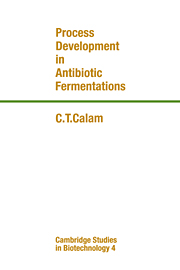Book contents
- Frontmatter
- Contents
- Preface
- Part 1 Background
- Part 2 Process development in the laboratory
- 7 Laboratory fermentation process development
- 8 Assessment and understanding of experimental results
- 9 Strain improvement
- 10 Methods for laboratory process development
- Part 3 Industrial fermentation plants and pilot plants
- Postscript
- Bibliography
- References
- Index
7 - Laboratory fermentation process development
Published online by Cambridge University Press: 05 February 2012
- Frontmatter
- Contents
- Preface
- Part 1 Background
- Part 2 Process development in the laboratory
- 7 Laboratory fermentation process development
- 8 Assessment and understanding of experimental results
- 9 Strain improvement
- 10 Methods for laboratory process development
- Part 3 Industrial fermentation plants and pilot plants
- Postscript
- Bibliography
- References
- Index
Summary
Introduction
The type of work required in this field is wide ranging and can vary from the simple to the elaborate types of experimentation. As experimental work is costly, there is a tendency to make many tests on individual batches, especially with stirred culture, and to obtain as much data as possible, often using standard routine methods. This can present a more-complicated picture than is currently needed, but it proves useful for future reference.
In earlier times, equipment was often designed and made by user firms. This was, in some ways, convenient, but it was expensive in time and in design costs. At present, equipment is usually made by specialised firms who supply not only shakers and fermenters but also ancillary equipment; these firms also carry out the installation. There is extensive instrumentation, both on the fermenters and in the analytical laboratory, and built-in computers are used for recording, control, storage of data, and its analysis. Some of these changes have been introduced to economise on staff and avoid over-night supervision.
To bring the subject into focus, Table 7.1 summarises some of the common types of fermentation apparatus and their intended uses. The numbers are not intended to be taken literally, but they give an indication of likely requirements. In general, the smaller sizes of equipment are used for academic work, or for screening and quick tests, where a few clear results are needed. Industrially, for laboratory work on process development, larger fermenters are preferred, for example 20–30-1 capacity, so as to avoid confusion over volume changes and to provide for extraction work.
- Type
- Chapter
- Information
- Process Development in Antibiotic Fermentations , pp. 77 - 92Publisher: Cambridge University PressPrint publication year: 1987

